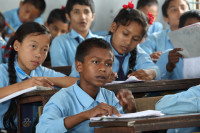Columns
Sustainable financing for health
Expansion of free health services is good, but its financial sustainability needs careful calibration.
Sagun Paudel
Sustainable health financing ensures adequate resources to meet a country’s health demands. This approach emphasises the need for stable resources, equitable allocation and efficient utilisation to improve accessible healthcare. It envisions reducing the financial burden on citizens, minimising out-of-pocket (OOP) expenditures and securing long-term funding for health services.
Various mechanisms contribute to sustainable health financing, such as public funding, domestic resource mobilisation and strategic mobilisation of international aid. These components support the demand and supply of healthcare services while strengthening health systems to ensure resilience, efficiency and equitability. An increase in public investment, effective management of resources, waste minimisation, reduction in reliance on external donors and enhancement of domestic revenue through taxes, insurance contributions and public-private partnerships are key strategies that help achieve sustainable financing.
In addition, robust financial protection mechanisms, such as health insurance schemes, other social protection programmes and strong public financial management, are all fundamental to sustaining healthcare access.
Budget scenario
The World Health Organisation (WHO) recommends that countries allocate at least 5 percent of their Gross Domestic Product (GDP) to healthcare to make significant progress toward Universal Health Coverage (UHC), ensuring that all people have access to the full range of quality health services they need in any circumstance without financial hardship.
However, Nepal doesn’t meet the WHO recommendation, as its health budget has usually been less than 5 percent of the national budget. Even though the government increased the sector’s budget by 8.6 percent during the Covid-19 pandemic (FY 2020-21), the lack of a substantial increase in budget in other fiscal years presents a significant challenge in meeting the funding needs required to achieve UHC and address the emerging burden of non-communicable diseases, existing communicable diseases and nutritional problems. Moreover, the absorption capacity of spending units within the Ministry of Health and Population, provincial government and local governments is not satisfactory.
Out-of-pocket payments problem
A primary concern in Nepal’s health financing is the high out-of-pocket payments, which accounted for 54.2 percent of total health expenditure in FY 2019-20. This means that for every Rs100 spent on healthcare, Nepali individuals pay Rs55-60 themselves. This proportion has remained unchanged for the last two decades. Such a heavy reliance on OOP payments places a considerable financial burden on households, making healthcare inaccessible for many, especially the poor and marginalised population.
To address these challenges, ensure the constitutional provision of health rights and implement the National Health Policy 2019 and Public Health Service Act 2018, the Nepal Health Sector Strategic Plan, 2023-2030 envisions Universal Health Coverage, ensuring equitable access to health services for all, especially marginalised groups. The plan focuses on strengthening the health system through increased public investment, good governance and the development of a sustainable financing system. A key goal is to enhance financial risk protection and reduce OOP expenditures, which can have catastrophic financial implications for many households.
The Nepal Health Financing Strategy 2023-2033 outlines a roadmap for increasing public investments, mobilising funds from diverse sources and improving resource pooling to enhance financial protection in health. It sets a bold target to increase health sector budget allocation to at least 10 percent at all government levels. The strategy emphasises the need to increase domestic revenue through taxation, insurance contributions, improved budget management and the integration of fragmented schemes. Additionally, the strategy advocates for performance-based resource allocation and improved efficiency in fund utilisation at all government levels.
However, its implementation has been challenging, as multi-sectoral stakeholders need to be convinced and committed to working together. It requires a robust political commitment at the highest levels to ensure alignment and collaboration across all sectors.
Impact of the US decision
The recent US Presidential order to cut development assistance poses a serious challenge for Nepal, especially considering the country’s reliance on foreign aid for health sector investments. This reduction in donor funds is expected to impact projects co-designed by the US and Nepal, potentially creating a funding gap for essential health programmes, particularly at the provincial and local levels for nutrition interventions, supply chain management systems, health system strengthening and various capacity-building initiatives.
Other major donors are also shifting their priorities towards overarching development sectors like climate change and social development. This serves as a wake-up call for the government of Nepal to significantly increase domestic resources.
Domestic resource mobilisation
Moreover, as Nepal transitions from Least Developed Country (LDC) status, there is a growing need to prioritise domestic resource mobilisation. This transition could adversely impact access to funds in terms of grants. Meanwhile, foreign aid is shifting, with donor grants declining and loans increasing. These changes could challenge the government to manage additional resources to access vaccines, equipment, health technology products, direct grants and technical support.
With reduced foreign grants expected in the future, Nepal must increase public investment and expand the tax base on harmful products like tobacco, alcohol (commonly known as sin taxes) and sugar-sweetened beverages (SSBs) through earmarked taxation on health. This will help Nepal have more resources to tackle the increasing burden of non-communicable diseases.
Nepal’s health policy has also made significant strides in ensuring that health is a fundamental right, with basic health services packages being provided free of cost. However, recent ministerial decisions by the Ministry of Health and Population have extended this promise beyond the integrated package of basic health services to include free services and free medicines for cancer, stroke and haemophilia, adding new financial burdens to the system. Such vertical initiatives will continue to add to the health system’s inefficiencies in the future. While expanding free health services is positive for the public, careful consideration is necessary to integrating various schemes, such as health insurance packages and the financial sustainability of these initiatives in the long term.
Despite challenges, Nepal can transition toward efficient domestic resource mobilisation for the health sector under federalism. The government must prioritise strengthening the capacity of its spending units to ensure efficient and planned spending throughout the fiscal year, avoiding rushed or last-minute expenditures. A sustainable, inclusive health system will ensure that every citizen has access to affordable healthcare while reducing the financial burden on households and enabling long-term improvements in health outcomes.




 18.12°C Kathmandu
18.12°C Kathmandu















